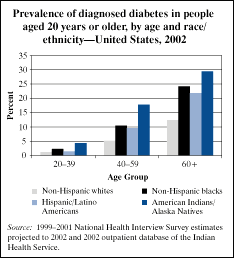
Diabetes and the
"Thrifty Gene" Hypothesis 
| Paleopathologists sought an answer as to why Type II diabetes is so prevalent in agricultural societies and what it was that actually led to insulin resistance. | |
| The "thrifty gene hypothesis" states that populations that consume low-carbohydrate, high-protein diets must accommodate to the low levels of glucose intake; and this would be insulin resistance. This insulin resistance would allow for increased blood glucose levels during periods of fasting, thus ensuring survival. Natural selection would then result in a high proportion of individuals with high insulin resistance; and geographic isolation would ensure that such a "thrifty" genotype would stay within populations. | |
| Modern thought believes that it's probable that these same "thrifty" alleles that favored fat accumulation and insulin resistance are what are now becoming detrimental due to calorie-rich diets and sedentary lifestyles. |
Demographic
Information and relations to a possible "thrifty" gene
![]()
| Prevalence of Type II diabetes appears to have a strong correlation with ethnicity. Study after study has shown that American Indians are diagnosed the most frequently with diabetes; and Europeans the least. |

(Source: NDIC)
| The thrifty gene hypothesis has been used to explain this discrepancy for several reasons: the Europeans were among the first to settle into agriculure and high carbohydrate diets, and thus the "thrifty" gene was less prevalent; whereas the Paleo-Indian populations maintained a hunter-gatherer mode of subsistence that relied heavily on unpredictable game source, so the "thrifty" gene further developed as an advantage during periods of fasting. | |
| The thrifty genome in these particular populations of American Indians could account for the high prevalence of Type II diabetes when a high-carbohydrate sedentary lifestyle was adopted. | |
| Current research is focusing on tracking "thrifty pathogenic traits" in youth for evidence of a correlation between a "thrifty" gene and obesity/Type II diabetes. |
(Content source: Wendorf, M. 1991; Brand-Miller and Colagiuri, 1994; Bougneres, P. 2002)